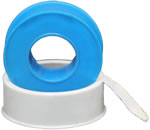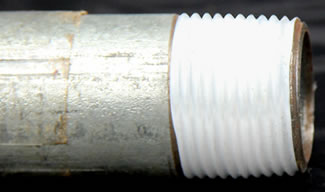How To Use PTFE Tape (Pipe Thread Seal)
Thread sealing tape, aka PTFE, is a very thin white tape used to wrap the threaded ends of metal and plastic pipes to lubricate the threads and prevent leaks where pipes join. The thin tape fills the minute gap between the male and female pipe threads stopping water leaks. The alternative is to use pipe dope, a paste type material which also seals and lubricates, allowing for a tighter joint. There is also a another variety of thread seal tape that is yellow. The yellow tape is heavier and is for use on gas line connections. Never use regular, white, PTFE tape on gas connections. PTFE stands for Polytetrafluoroethylene, the most well known variety of this product is Teflon®, by Chemours.
Caution: Please read our safety information before attempting any testing or repairs. Use of PTFE Pipe Thread Sealing tape does not guarantee a leak free connection. Always inspect connections, with water pressure, for leaks before sealing them from access.

People often ask the following questions about the use of pipe sealing PTFE tape.
How much PTFE tape should I use?
How many times around should I wrap PTFE tape?
Which direction should PTFE tape be wrapped?
- Clean the pipe threads with a rag before applying the PTFE tape.
- Start wrapping the male threads at very end of the pipe, but do not let the tape lap over the end. If the tape laps over the end of the pipe it can reduce water pressure and even cause clogs from bits of the tape that get pulled into the water line.
- Start with a couple loops around at the end, then wrap all the threads, overlapping half the width of the tape on each wind.
- Wrap in the direction of the threads starting from the end and proceeding toward the length of the pipe. Wrapping the wrong way may result in the tape coming unwound as the fittings are tightened.
- As you wrap, keep tension on the tape so that it is pulled into the threads.
- If you loosen or disconnect a fitting, remove the old tape and re-wrap it with a fresh piece.

For more answers to your plumbing questions, visit our plumbing department.
| |||||





